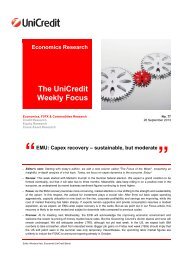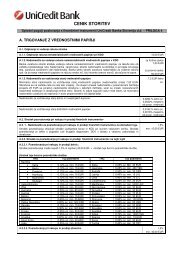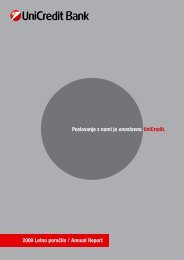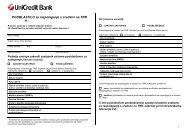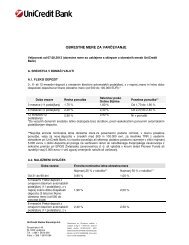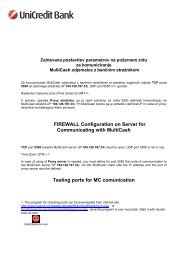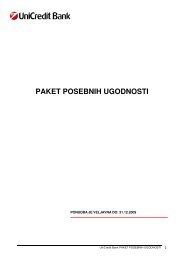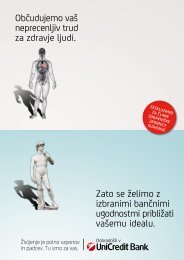Letno poroÄilo 2007 - UniCredit Banka Slovenija dd
Letno poroÄilo 2007 - UniCredit Banka Slovenija dd
Letno poroÄilo 2007 - UniCredit Banka Slovenija dd
You also want an ePaper? Increase the reach of your titles
YUMPU automatically turns print PDFs into web optimized ePapers that Google loves.
Business ReportManaging Business Risksimpairments was actually reduced by 8.5%, highlighting that in 2006, the Bankuniquely formed impairments in the amountof 1 million euros due to the introduction ofInternational Accounting Standards. If therewas no such effect, the level of impairmentswould increase by 16.2 %, which complieswith the growth of the Bank’s portfolio.In <strong>2007</strong>, the Bank substantially increasedthe amount of repaid, impaired loans(4.9 million euros), which shows that thedepartment entrusted with loan renewal iswell formed and organised.When forming impairments, the <strong>Banka</strong>pplies various measures for early detectionof potentially bad loans. The Bank followson a monthly basis the movement ofcompanies’ ratings, loan defaults andlate bank payments and regularly followscorporate clients’ individual transactionswith at least annual documented businessand event review. The Bank employs adiscounted future cash flow method tocalculate impairments. In <strong>2007</strong>, for thefirst time, the Bank a<strong>dd</strong>itionally formedimpairments for the so called unidentifiedevents in the amount of 400,000 euros,which, in a<strong>dd</strong>ition to 3.9 million euros fromindividual provisions, represents the totalof all impairments in <strong>2007</strong>. The amountof a<strong>dd</strong>itional impairments is aligned withthe budgeted amount, which proves thatthe methodology used by the Bank wasadequate and correct.A detailed and regular analysis of theportfolio and numerous comparisons madeon the level of <strong>UniCredit</strong> Group confirmedthat the Bank has a high quality andbalanced portfolio, which has been retaine<strong>dd</strong>espite growth. Similar to previous years,the Bank maintained a stable and qualityportfolio structure again in <strong>2007</strong>, with morethan 95 % exposure with the highest creditrating ‘A’. To further reduce the credit riskof its entire portfolio, the Bank providesfor adequate dispersion of loans among itsnumerous clients and segmentation intovarious economic activities. The preparationof such analysis with respect to activity, sizeof business, credit form, etc. enables theBank to react quickly in case of recorde<strong>dd</strong>eterioration of any indicators.In <strong>2007</strong>, the Bank focused a majority ofactivities on meeting Basel requirements,such as checking the quality of collateral,provided as a pledge for the bank exposure.The Bank formed all the necessary projectfunctions enabling it to implement plannedactivities to meet the requirements incompliance with the IRB approach.Information TechnologySupportIn the area of information technology andoptimization of business processes, <strong>2007</strong>was marked with several important projects at<strong>UniCredit</strong> <strong>Banka</strong> <strong>Slovenija</strong> d.d. These projectsincluded: preparing for the introduction ofBasel standards; implementing requirementsfrom the European directive on Market inFinancial Instruments (MiFiD); introducingthe Slovenian clients’ credit ratinginformation system - for individual clients- (SISBON); preparing for the introductionof a single euro payment area (SEPA); andthe transition of all banking cards to chiptechnology.In accordance with Basel standards, in <strong>2007</strong>we continued with the project of setting upa back-up IT centre. As a result of theseendeavours, we now have two interconnectedIT centres, which alternately conduct tasksbased on the current availability of resources.If one centre fails, the other one resumes theentire Bank’s information and communicationsupport. During last year we thus completedthe project of increasing the reliability ofthe Bank’s information support. The projectbegan in 2005 with the transfer of the coreinformation system to the Group’s central ITcentre in Vienna, while in 2006 and <strong>2007</strong>we continued with the increase of reliabilityof all satellite systems and communications.The European MiFiD directive requirednumerous adjustments on the central bankinformation system as well as on satellitesystems for supporting business withfinancial instruments. In order to createa better basis for expanding our offer ofservices related to securities trading, inthe second half of <strong>2007</strong> we replaced theinformation system for this segment with anew one.We at <strong>UniCredit</strong> <strong>Banka</strong> <strong>Slovenija</strong> d.d. havealways been aware of the utmost importanceof exchanging data on clients’ credit ratingsamong Slovenian banks and consequentlyof the introduction of SISBON system in ourbank. Therefore, we started all the requiredpreparations in the central informationsystem right away and we completed themon time.The introduction of the single payment areain euros (SEPA) has most certainly beenone of the most demanding projects in thearea of payment systems in the last years.We started preparations for this project in2006 and upon Slovenian adoption of theeuro, preparations intensified. The projectwas also launched at the entire <strong>UniCredit</strong>Group level. In order for the Group to remainharmonized in the European region and toachieve cost efficiency, we decided to enterSEPA payment systems through the centralaccess point in Vienna. At the same time,we decided to support all specific servicesenabled by SEPA standards that wereavailable at the national level.Year <strong>2007</strong> also brought the replacement134 <strong>2007</strong> Annual Report · <strong>UniCredit</strong> Bank



